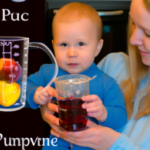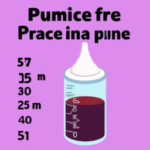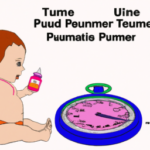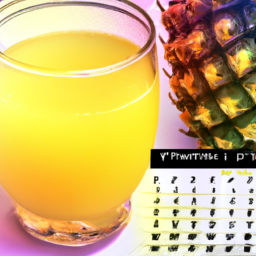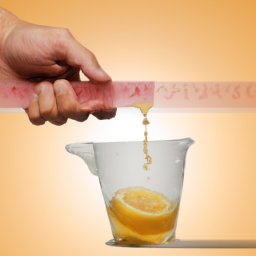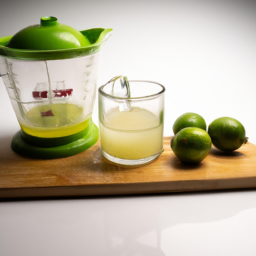As a parent, there are few things more distressing than seeing your child having difficulty with constipation. This problem impacts a large number of children, with up to 30% experiencing it at some point. Over time, prune juice has become a preferred solution among the various options available to alleviate constipation.
But how much prune juice is safe for a 3-year-old? Prune juice is a natural laxative that can help soften stool and promote bowel movements. It’s packed with fiber, sorbitol, and other compounds that can help regulate digestion. However, it’s essential to be cautious when giving prune juice to young children, as too much can cause adverse effects.
In this article, I’ll dive into the benefits of prune juice, recommended serving sizes for a 3-year-old, potential side effects, and other ways to relieve constipation. Let’s get started.
Key Takeaways
- Prune juice can be a natural laxative that can help relieve constipation in children.
- The appropriate serving size for a 3-year-old child is 4-6 ounces per day to avoid potential side effects like diarrhea or abdominal discomfort.
- Always consult with a pediatrician before making significant changes to a child’s diet or exercise routine and to monitor progress.
- Choose organic prune juice and store it properly to preserve its nutritional value.
Understanding Constipation in Children
If your little one is having trouble pooping, they might be dealing with constipation, which can be a real pain in the butt (pun intended)!
Constipation is a common problem in children. It happens when they have difficulty passing stool or when they don’t go as often as they should. Common causes of constipation in children include dehydration, lack of fiber in their diet, and holding in their poop for too long.
To prevent constipation in children, it’s important to encourage them to drink plenty of fluids, eat a diet rich in fiber, and establish a regular bathroom routine. This means that you should encourage your child to go to the bathroom at the same time every day, preferably after a meal.
Additionally, you should limit their intake of constipating foods such as bananas, cheese, and processed foods. If your child is still struggling with constipation, you may want to consider giving them prune juice, which has been known to help with bowel movements.
As we move on to discussing the benefits of prune juice, it’s important to note that you should always consult with your child’s pediatrician before making any changes to their diet or giving them any new foods or beverages.
Benefits of Prune Juice
You’ll be pleased to know that prune juice has been shown to improve digestion and promote regularity in children. Studies have found that regular consumption of this fruit juice can significantly reduce constipation in young ones.
Here are some benefits of prune juice that parents should know:
- Prune juice is a good source of fiber, which is essential for maintaining a healthy digestive system.
- It contains sorbitol, a natural laxative that helps soften the stool and make it easier to pass.
- Prune juice is rich in vitamins and minerals, including vitamin C, potassium, and iron, which are important for overall health and well-being.
- This fruit juice is low in calories and has no fat, making it a healthy option for children who need to maintain a healthy weight.
- Prune juice can be used in a variety of recipes, such as smoothies, baked goods, and sauces, to add flavor and nutrition.
Knowing the benefits of prune juice, parents may wonder how much of it is safe to give to their 3-year-old child. Let’s explore the recommended serving size in the next section.
Recommended Serving Size for a 3-Year-Old
The appropriate serving size for a 3-year-old child can be determined based on their weight and dietary needs. As a general rule, a serving size of prune juice for a child this age should be limited to 4-6 ounces per day. However, it is important to note that some children may not tolerate prune juice well or may have other dietary restrictions that prevent them from consuming it. In these cases, there are several prune juice alternatives that can provide similar benefits, such as dried prunes or other high-fiber fruits.
If your child is a picky eater and refuses to drink prune juice, there are a few strategies you can try to encourage them to consume it. For example, you could try mixing it with other juices or blending it with fruits and vegetables to make a smoothie. Additionally, it may be helpful to introduce prune juice gradually and in small amounts to allow your child to become accustomed to the taste and texture. Ultimately, it is important to consult with your child’s pediatrician to determine the appropriate serving size and to ensure that they are meeting their nutritional needs.
Excessive consumption of prune juice can lead to potential side effects, such as diarrhea or abdominal discomfort. It is important to monitor your child’s intake and to avoid giving them more than the recommended serving size. In the next section, we will discuss these potential side effects in more detail and provide tips for managing them.
Potential Side Effects of Excessive Prune Juice Consumption
Watch out! Consuming too much prune juice can lead to some unpleasant side effects. While prune juice is known for its ability to relieve constipation, an overdose can cause diarrhea, stomach cramps, and even dehydration.
This is because prune juice contains sorbitol, a sugar alcohol that can have a laxative effect when consumed in large amounts. It’s important to keep in mind the potential risks of excessive prune juice consumption, especially for young children.
A three-year-old should only have a small amount of prune juice, about 2-4 ounces per day. If your child experiences any discomfort or negative side effects, it’s best to stop giving them prune juice and consult with a pediatrician.
Other ways to relieve constipation include increasing fiber intake, drinking plenty of water, and staying active.
Other Ways to Relieve Constipation
To alleviate constipation, there are several natural remedies and dietary changes that can be made. One effective method is to increase fiber intake by incorporating more fruits, vegetables, and whole grains into the diet. It’s important to introduce fiber gradually and to drink plenty of water to avoid further constipation.
Another way to relieve constipation is to stay hydrated by drinking plenty of water and avoiding sugary drinks. Regular exercise can also help stimulate bowel movements and improve overall digestive health.
It’s important to note that while these methods can be effective, it’s always best to consult with a pediatrician before making any significant changes to a child’s diet or exercise routine. A pediatrician can provide guidance on proper amounts of fiber and hydration for a child’s age and weight, as well as recommend any additional treatments if necessary.
By working with a pediatrician, parents can ensure that their child is receiving the proper care and treatment for constipation.
Consult with a Pediatrician
Consulting with a pediatrician can ensure that a child is receiving appropriate treatment and care for constipation, including guidance on fiber and hydration. Pediatrician consultation is particularly important when it comes to determining the dosage of prune juice for a child. While prune juice can be an effective natural laxative, it’s important to ensure dosage accuracy to avoid any potential side effects or complications.
Here are some reasons why consulting with a pediatrician is crucial when introducing prune juice to your child’s diet:
- A pediatrician can recommend the appropriate dosage of prune juice based on your child’s age, weight, and overall health.
- They can also provide guidance on when and how to introduce prune juice to your child’s diet.
- A pediatrician can monitor your child’s progress and adjust the treatment plan accordingly.
- They can also identify any underlying medical conditions that may be contributing to constipation and provide appropriate treatment.
Considering all of these factors, it’s important to consult with a pediatrician before giving prune juice to your child. By doing so, you can ensure that your child’s receiving safe and effective treatment for constipation.
Introducing Prune Juice to Your Child’s Diet
Before giving your child prune juice, it’s important to consult with a pediatrician. Once you have the go signal, you can introduce prune juice to your child’s diet. Prune juice is an excellent source of fiber and can help relieve constipation. However, too much prune juice can have adverse effects.
If your child doesn’t like the taste of prune juice, there are other alternatives to consider. You can try giving them fiber-rich foods such as fruits, vegetables, and whole grains. These foods can also help alleviate constipation and provide necessary nutrients for growth and development. Gradually introduce fiber-rich foods to your child’s diet to avoid digestive issues.
It’s important to take precautions when giving prune juice and other fiber-rich foods to your child. In the next section, we will discuss some of the precautions you should take when introducing prune juice to your child’s diet.
Precautions
As a parent, I always keep in mind the importance of avoiding added sugars in my child’s diet. When introducing prune juice, it’s crucial to read labels and choose organic options to ensure that there are no added sugars or harmful chemicals.
Being cautious about what my child consumes is my top priority, and making informed choices about their food and drinks is an essential part of that responsibility.
Avoiding Added Sugars
You don’t want to give your 3-year-old too much sugar, so it’s important to be mindful of the amount of prune juice you give them. Reducing sugar intake in children is crucial in maintaining their health and well-being.
One way to do this is by choosing prune juice that is low in added sugars. When shopping for prune juice, make sure to read the labels and check for any added sugars. Look for juice that is labeled as 100% fruit juice, which means it contains no added sugars. You can also opt for unsweetened prune juice, which is a healthier option for your little one.
Another way to ensure healthy hydration for your child is by serving them prune juice in moderation. The American Academy of Pediatrics recommends that children between the ages of 1 to 3 years old should consume no more than 4 ounces of juice per day. This is to prevent excessive sugar intake and to encourage children to drink water instead.
By following these guidelines, you can ensure that your child is getting the proper amount of hydration and nutrients they need without compromising their health. Choosing organic prune juice is also a great option as it ensures that your child is consuming a product that is free from harmful pesticides and chemicals.
Choosing Organic Prune Juice
As I mentioned earlier, it’s important to avoid added sugars when giving prune juice to a three-year-old. One way to do this is to choose an organic prune juice.
Organic certification ensures that the juice has been produced without the use of synthetic pesticides, fertilizers, or genetically modified organisms. This means that the juice is free from harmful chemicals that could be harmful to a child’s developing body.
When choosing an organic prune juice, it’s also important to consider taste preferences. Some brands may have a stronger or sweeter taste than others, which could affect whether or not a child enjoys drinking it. Additionally, some brands may use different varieties of prunes, which can also affect the taste.
To ensure that your child enjoys the juice and is more likely to drink it, it may be helpful to try different brands and varieties until you find one that they like.
Moving on to the next topic, let’s talk about how to store and serve prune juice to your little one.
Storing and Serving Prune Juice
When it comes to storing and serving prune juice, there are a few key things to keep in mind. Firstly, it’s important to store prune juice in a cool, dry place away from direct sunlight.
Secondly, always check the expiration date before serving prune juice to ensure it’s still safe to consume.
Lastly, serve prune juice chilled or at room temperature for optimal taste and safety. As a knowledgeable caregiver, I always make sure to follow these precautions when serving prune juice to my little ones.
Proper Storage
Hey there, storing prune juice properly can help keep it fresh for your little one. It’s important to keep in mind that proper storage will not only make it last longer but also help preserve its nutritional value. Here are some things to keep in mind when storing prune juice:
-
Refrigerate after opening: Once the bottle is opened, it’s important to keep the prune juice in the fridge. This will help slow down the growth of bacteria and keep it fresh for longer.
-
Use within a week: Prune juice has a shelf life, even when refrigerated. It’s best to use it within a week of opening to ensure the highest quality possible.
-
Keep it covered: Make sure to tightly seal the bottle or container after each use to prevent air and bacteria from getting in.
-
Avoid contamination: When pouring prune juice, make sure to use a clean glass or cup to prevent any contamination from outside sources.
When it comes to serving prune juice to your little one, it’s important to not only store it properly but also serve it at a safe temperature. Let’s take a look at how to do that.
Safe Serving Temperature
To make sure your little one is safe and healthy, you need to serve prune juice at a temperature that won’t burn their delicate mouth and throat. The ideal serving temperature for prune juice is between 60-65 degrees Fahrenheit. This temperature is cool enough to prevent any burns or discomfort, but it’s still warm enough to enhance the flavor of the juice.
To ensure that your child enjoys their prune juice, you can try serving it in a cup or sippy cup with a straw. This will make it easier for them to drink and prevent any spills or messes. It’s also important to note that prune juice should be consumed in moderation, as too much fiber can cause stomach discomfort. As a general rule, you can start with a small amount, such as 1-2 ounces per day, and gradually increase the serving size as your child gets used to it. Overall, prune juice can be a nutritious and tasty addition to your child’s diet, but it’s important to follow these serving tips and consider its nutritional value.
| Nutrient | Amount per 8 oz | % Daily Value |
|---|---|---|
| Calories | 120 | 6% |
| Total Fat | 0g | 0% |
| Sodium | 15mg | 1% |
| Total Carbohydrate | 31g | 10% |
| Dietary Fiber | 2g | 8% |
| Sugars | 23g | N/A |
| Protein | 1g | N/A |
Prune juice is a good source of fiber, which can help regulate digestion and prevent constipation. It’s also a good source of potassium, which helps maintain healthy blood pressure levels. However, it’s important to note that prune juice is high in sugar, so it should be consumed in moderation. As with any food or beverage, it’s important to consider the nutritional value and serving size when incorporating it into your child’s diet. By following these serving tips and being mindful of its nutritional value, you can safely and deliciously incorporate prune juice into your child’s diet.
Frequently Asked Questions
Can prune juice be given to a child younger than 3 years old?
As a professional, I advise that prune juice can be beneficial for children, but caution should be taken when giving it to those under 3. Benefits include aiding digestion and constipation relief, but potential side effects include stomach cramps and diarrhea.
How long does it take for prune juice to relieve constipation in a 3-year-old?
Prune juice dosage can vary based on age and weight, but typically 1-2 ounces is safe for a 3-year-old. Results may vary, but typically, it takes a few hours to a day for prune juice to relieve constipation and improve toddler bowel movements. It’s important to not give too much prune juice, as it can cause diarrhea and dehydration.
Is it safe to mix prune juice with other drinks or foods?
Possible drawbacks of mixing prune juice with other drinks or foods include diluting its effectiveness and causing stomach upset. Recommended dosage for prune juice is 1-2 ounces per day. Potential interactions and safety concerns should be discussed with a pediatrician.
Can prune juice cause diarrhea in a 3-year-old?
Prune juice can cause diarrhea in a 3-year-old if consumed in excess. It is important to be cautious with prune juice dosage and monitor for any side effects. Always consult with a pediatrician before introducing new foods or drinks.
Are there any natural alternatives to prune juice for relieving constipation in children?
Looking for natural alternatives to relieve constipation in children? Try fruit alternatives like prunes or pears, or herbal remedies like aloe vera or senna. Always consult with a pediatrician before trying any new treatment.
Conclusion
In conclusion, I highly recommend prune juice as a natural and effective remedy for constipation in 3-year-olds. As a parent, I understand the importance of finding safe and gentle solutions for our little ones.
With its high fiber content and natural laxative properties, prune juice can help promote regular bowel movements and alleviate discomfort. However, it’s crucial to follow the recommended serving size and watch out for any potential side effects.
When introducing prune juice to your child’s diet, start with small amounts and gradually increase as their system adjusts. Always consult with your pediatrician before making any significant changes to your child’s diet or if you have any concerns about their bowel movements.
Remember to store and serve prune juice properly by keeping it refrigerated and discarding any unused portions after a few days. Overall, prune juice can be a valuable tool in managing constipation in young children.
With a little bit of caution and careful monitoring, you can help your child feel more comfortable and happy. So why not give it a try and see the difference it can make in your child’s digestive health?
Ilana has been a vegan for over 10 years. She originally made the switch for health reasons, but soon found herself becoming more and more passionate about the ethical and environmental implications of a vegan lifestyle. Ilana is the author of The Graceful Kitchen, a blog all about veganism. She loves to cook up delicious and nutritious vegan meals, and share her recipes with others who are interested in leading a cruelty-free life. Ilana is also a strong advocate for using whole foods as the foundation of a healthy diet, and believes that going vegan is one of the best ways to achieve this.



